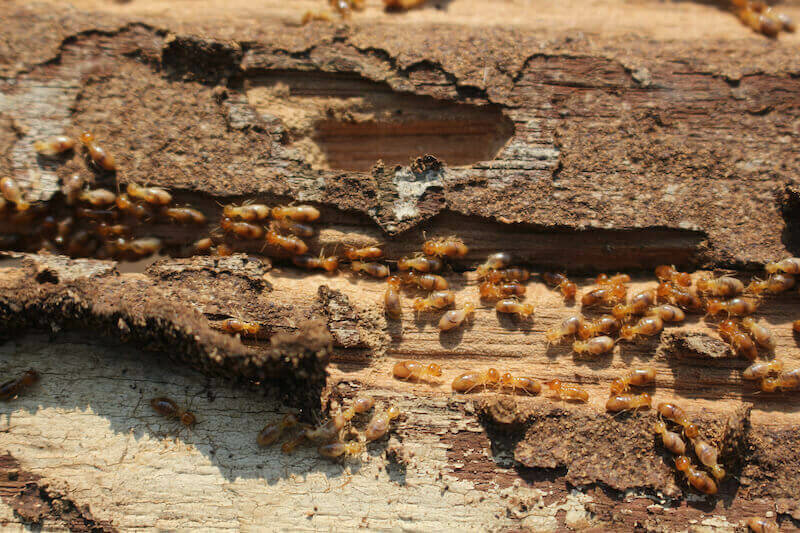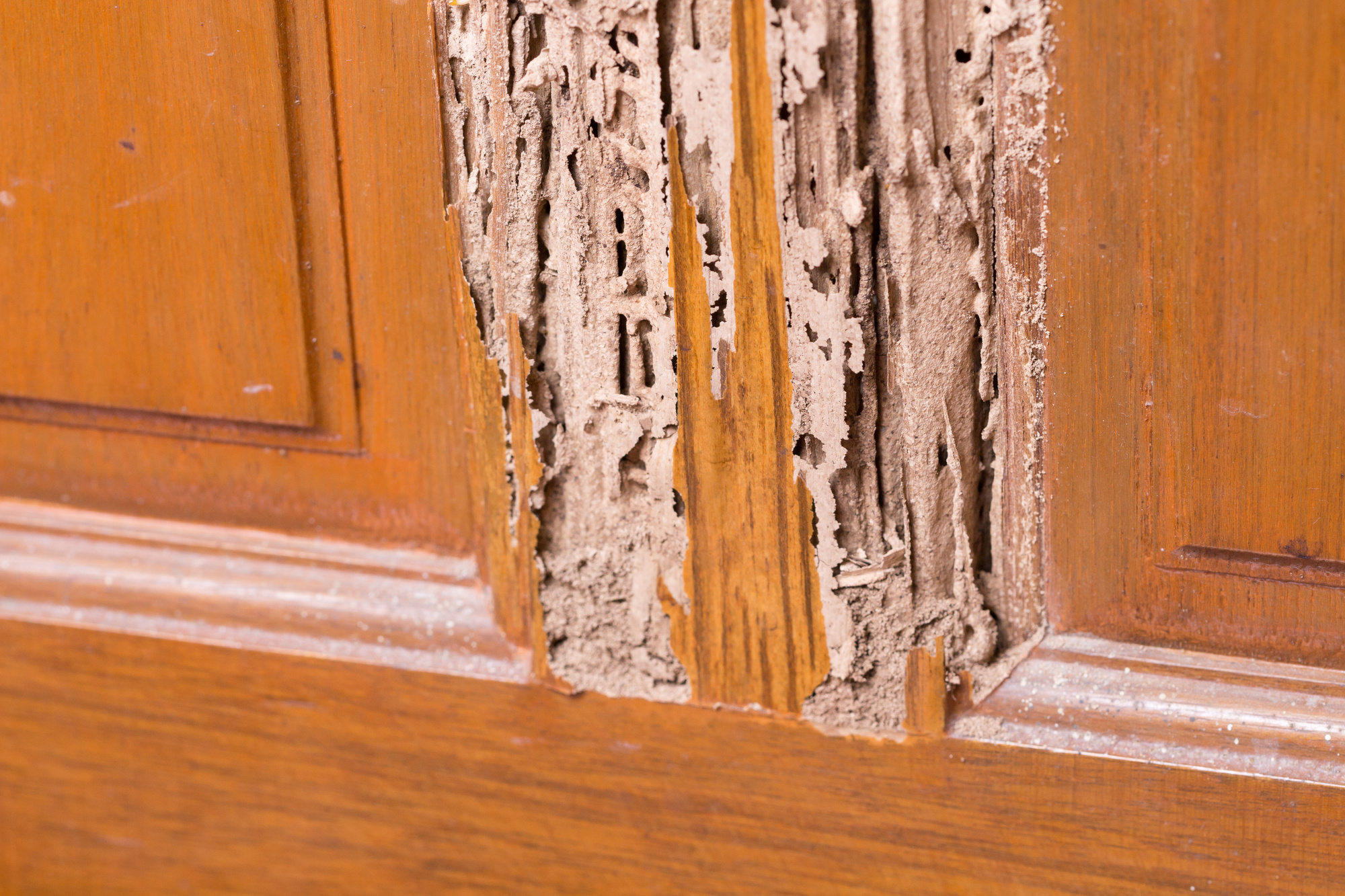Professional Termite Removal in Austin
Serving Georgetown, New Braunfels, Round Rock, and San Marcos
Pest Control Xperts delivers thorough termite removal for homes, historic properties, restaurants, health care clinics, tech campuses, and rental communities throughout Austin. Termites silently hollow framing, floor joists, and roof decks from the inside. By the time winged swarmers drift across a living room window in Round Rock or appear beside a service door downtown, thousands of workers may already be feasting on hidden structural wood. Because Central Texas features warm summers, repeated spring rain, and winters that rarely remain cold for long, subterranean colonies stay active much of the year. Our local exterminator team couples careful inspection with science driven treatment and straightforward prevention guidance so property owners in Austin, Georgetown, New Braunfels, and San Marcos protect their investment and keep it sound.
Why Termites Thrive in Central Texas
Austin straddles the Balcones Escarpment where humid Gulf air meets limestone hills. Spring thunderstorms soak Blackland Prairie clay and Hill Country rocky loam, raising ground moisture that subterranean termites need. Daytime temperatures often reach the nineties from May through September. Even in January the mercury frequently returns to the sixties, keeping soil warm enough for year round foraging.
Residential irrigation adds to the challenge. Watering systems in Georgetown subdivisions maintain constant damp zones along slab foundations. Restaurants on South Congress wash patios each night, sending runoff under decorative timbers that contact soil. Meanwhile the Colorado River and its tributaries provide natural corridors that let termite colonies migrate beneath bridges and along greenbelts without exposure to predators.
Construction patterns feed termite risk as well. New Braunfels continues to add vacation homes near the Comal River. Builders sometimes bury scrap from boards or leave wooden pallets in grade backfill. These cellulose leftovers invite Eastern subterranean termites to set up base stations near plumbing penetrations.

Seasonal Termite Activity
Early Spring
First warm rain triggers swarms. Discarded wings collect on windowsills of San Marcos student housing. Quick action now prevents major repairs later.
Summer Peak
Soil temperatures rise above eighty degrees which accelerates feeding. Formosan subterranean colonies in downtown Austin can hollow structural beams at double the rate seen in cooler seasons.
Autumn Return Rains
September storms soften soil that dried during July heat. Workers expand mud tunnels beneath patio slabs and garage footings of Round Rock starter homes.
Mild Winter
Workers continue to feed slowly inside heated crawl spaces and interior wall studs. Colonies enlarge secondary chambers upward into attic lumber where roof leaks raise humidity.
Subterranean Termites Found in the Region
Eastern subterranean termite
Most common across the metro. Colony size reaches fifty thousand or more. Visible pencil wide tubes appear along pier posts and brick mortar. Damage grows serious in three to five years if untreated.
Formosan subterranean termite
Aggressive colonies sometimes containing over one million workers. Swarms at dusk from mid May through June. Known to build self contained carton nests inside walls which keeps the colony moist even when soil dries.
Arid land subterranean termite
Prefers rocky soils on the western fringe near Lake Travis and rural Georgetown. Colonies remain smaller yet spread outward across porch posts, deck joists, and cedar pergolas.
Drywood termites are uncommon but arrive in antique furniture and reclaimed beams sold in Austin vintage markets. Technicians inspect suspect items during service visits to prevent hidden introductions.
Signs Termites Are Active
- Discarded translucent wings on window ledges, porch chairs, or under exterior lights
- Mud tubes climbing slab edges, plumbing lines, or pier support columns
- Blistered paint and subtle ripples on drywall that suggest moisture behind the surface
- Hollow sounding wood or unexplained soft spots in hardwood flooring
- Doors and windows that suddenly stick because framing no longer holds square
- Sagging porch steps where hidden galleries removed supporting cellulose
Any one of these clues warrants professional evaluation by an experienced exterminator in Austin.

The Cost of Delay
Termites cause billions of dollars in damage across the country each year. Most property insurance excludes insect destruction, so owners must pay repair costs out of pocket. Replacing sill plates, subfloor panels, or roof decking often exceeds the original construction budget. When inspectors find active termites during a sale in Georgetown or a refinancing appraisal in New Braunfels, deals can collapse until treatment and repairs finish. Timely removal and proactive monitoring save significant money and stress.
Pest Control Xperts Five Step Removal Plan
- Intensive Inspection
A certified inspector surveys every accessible area from foundation soil to attic ridge. Moisture meters record wood content, infrared cameras reveal heat from active galleries, and probing tools test for internal hollows. We photograph findings and produce a digital floor plan marking each risk point. - Species Confirmation and Risk Mapping
Captured workers and soldiers go under magnification to identify species. Soil type, gutter drainage, landscape timber contact, and onsite irrigation are noted. This data drives treatment design tailored to each structure. - Custom Treatment Choices
- Non Repellent liquid barrier is trenched into soil surrounding the foundation. Workers pass through treated zones unaware, transfer active ingredients within the colony, and the entire network collapses.
- In ground bait system installs low profile stations every ten feet when patios or mature landscaping block trenching. Termites feed on cellulose bait with an insect growth regulator that stops reproduction.
- Foam application fills wall voids around hidden tubes behind showers, under tub platforms, or in attic eaves, reaching spots without cutting drywall.
- Borate wood treatment protects exposed framing during remodels or new builds by penetrating raw lumber and creating a long term deterrent.
- Moisture and Structural Corrections
Technicians recommend extending downspouts away from siding, pulling mulch back six inches, fixing dripping hose bibs, and adding vapor barriers in pier and beam crawl spaces. Exclusion work might include sealing slab cracks with epoxy filler and installing stainless screening over roof vents. - Monitoring and Maintenance
Liquid barriers receive annual checkups to ensure soil coverage remains sound after landscaping or plumbing repairs. Bait stations are inspected quarterly until activity ends, then twice per year for early warning. Digital logs capture swarm sightings, moisture readings, and service dates.
Community Focused Service Highlights
Downtown Austin
Many buildings on Congress Avenue feature limestone basements with damp mortar. Portable injection rigs protect historic masonry without visible trench lines. Evening scheduling prevents noise during business hours.
Georgetown Square
Pier and beam homes with cypress beams call for crawl space foam and borate coating. Crews install vent fans to lower humidity and place bait along shaded garden borders.
Round Rock Tech Corridor
Server farms built on wide slabs have few soil contact points. We core drill through expansion joints, treat beneath slab, and seal openings flush so forklift traffic resumes immediately.
New Braunfels River District
Vacation rentals near the Comal River demand rapid turnaround. One day bait installation covers fence lines and deck supports, followed by a digital clearance letter for short term rental compliance.
San Marcos Student Housing
Multiple buildings share common green spaces. Site wide bait grids provide neighborhood level protection, and quarterly email reports help property managers meet university safety requirements.

Why Choose Pest Control Xperts
- Local expertise built on decades of Central Texas climate data, soil surveys, and swarm tracking
- Integrated solution that blends barrier chemistry, bait technology, foam, borate, and moisture control rather than one size fits all spraying
- Transparent reporting delivered through a secure portal including photos, treatment diagrams, and product safety sheets for lenders, realtors, and permitting offices
- Flexible scheduling with sunrise, evening, and weekend service to match restaurant hours, medical clinic operations, and homeowner availability
- Maintenance options that cost less over time than repeated emergency treatments and preserve property value through documented protection
Everyday Prevention Tips
- Keep mulch layers shallow and at least six inches clear of siding.
- Store firewood on a metal rack elevated eighteen inches off soil and twenty feet from exterior walls.
- Direct sprinkler heads away from the foundation to avoid chronic dampness.
- Repair gutter leaks and grade soil so water flows away from structures.
- Trim shrubs so leaves never touch brick or stucco allowing air flow and sunlight.
- Inspect attic and crawl space twice each year for roof leaks that raise wood moisture.
- Use pressure treated lumber for deck posts and soil contact features.
- Ask contractors to remove scrap boards and wooden form stakes after concrete pours.
- Seal foundation cracks with professional grade epoxy to block hidden termite paths.
- Schedule a termite inspection every two years or annually in a known high pressure zone.
Frequently Asked Questions
How long will treatment take
Most single family homes receive full barrier or bait installation in one day. Foam and borate spot work add only a few hours.
Is treatment safe for pets and gardens
Termiticides bind tightly to soil below grade. Baits sit inside locked stations. Application follows all Environmental Protection Agency label directions for ornamental plant safety.
Do residents need to leave the home
No. Work happens outside or inside wall voids. Residents can remain inside and resume routine once any odorless foam or liquid dries, usually in about two hours.
Contact Pest Control Xperts Today
Mud tubes on slab edges, hollow sounding trim, or clusters of discarded wings are signals termites are already feeding. Acting quickly limits repair bills and preserves resale value. Pest Control Xperts is ready with prompt termite removal in Austin, Georgetown, Round Rock, New Braunfels, and San Marcos. Our exterminator team inspects thoroughly, applies precise treatments, and gives clear steps to keep colonies from returning. Contact us today to schedule a full evaluation or enroll in a preventative maintenance plan that secures your property through every season.
